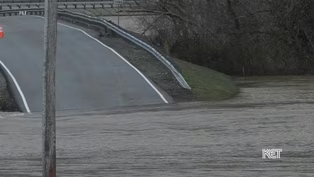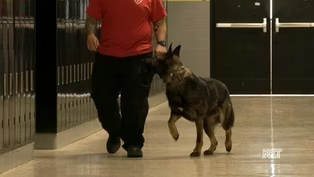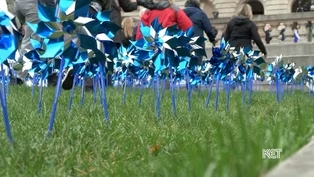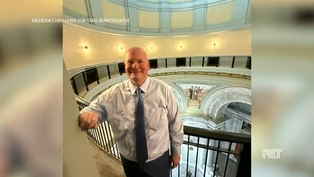
UK Professor Leading In-Depth Water Research
Clip: Season 3 Episode 219 | 3m 9sVideo has Closed Captions
It's the most in-depth study on the contaminants in our rivers and streams.
A recent study done in part by the University of Kentucky took a closer look at what's going on in our waterways. It's the most in-depth research study so far on the contaminants flowing through our rivers and streams.
Problems playing video? | Closed Captioning Feedback
Problems playing video? | Closed Captioning Feedback
Kentucky Edition is a local public television program presented by KET

UK Professor Leading In-Depth Water Research
Clip: Season 3 Episode 219 | 3m 9sVideo has Closed Captions
A recent study done in part by the University of Kentucky took a closer look at what's going on in our waterways. It's the most in-depth research study so far on the contaminants flowing through our rivers and streams.
Problems playing video? | Closed Captioning Feedback
How to Watch Kentucky Edition
Kentucky Edition is available to stream on pbs.org and the free PBS App, available on iPhone, Apple TV, Android TV, Android smartphones, Amazon Fire TV, Amazon Fire Tablet, Roku, Samsung Smart TV, and Vizio.
Providing Support for PBS.org
Learn Moreabout PBS online sponsorshipA recent study, done in part by the University of Kentucky, took a closer look at what's going on in our waterways.
It's the most in-depth research study so far on the contaminants flowing through our rivers and streams.
Here are more from the UK.
Professor leading the charge.
So 95% of Kentucky's drinking water comes from surface water sources.
And so it's really important that our rivers stay clean, because the majority of our water that we're going to be using to drink is coming from rivers.
There are two different ways we were monitoring.
We're doing what we call gravity.
This is where you take a bottle, you put it inside the water and you grab a sample and you take it back to our lab.
Then we also have this thing called a process.
And what this is, is it looks like a canister.
And it has these, this thing called a membrane in it.
And that membrane will actually absorb different contaminants in your water and give you an average concentration of what we're seeing in your water.
When you do a grab sample, it's kind of like a snapshot of what's inside of your stream at that point.
Versus the process will give us an average concentration.
If you have a chronic situation happening in your stream that you wouldn't be able to see otherwise.
More rural areas.
Typically in agricultural areas, we typically only saw particularly pesticides one time of year, and that's not surprising.
Typically, agricultural areas will apply pesticides in the spring when they're putting in their crops.
It's a little bit different in urban settings, and we have a lot more yards with a lot more people that apply a lot more pesticides and probably is needed on the yards.
And so in the urban settings, it was more of a chronic issue where we saw high pesticides in the water a lot like throughout the year.
So we've been working on coming up with what we call ecological solutions.
This is trying to use nature to improve our water quality.
And so we've actually been working on an engineer designed wetland that you can put on things like ponds and reservoirs that actually will remove some of the contaminants without taking up any space around the area.
So been working with a lot of farmers, wastewater treatment plant operators, and we also been working with some of the distilleries on how we can use these to improve our water quality and our different water bodies.
So this is funded from the National Science Foundation under a career award.
And the key to those awards is you're trying to engage the community along with doing the research.
Then we would actually work with the high schools, and they would actually do the same experiments that we were doing at a larger scale at the University of Kentucky and validate our findings with what they were seeing in their own labs, at their high schools.
So this is an example of what we've been doing with the high schools.
We have this in a much larger scale.
Think of like bathtub size in our greenhouses at University of Kentucky's campus.
The students will actually put the nutrients into the cosmos, along with some of the treatments will actually have the emerging contaminant that we've been seeing, such as caffeine, atrazine, which is a type of herbicide.
We've had Senator put sulfate from like what we saw on the mining area, and we've had a few that have put some different types of like things like a of Clifford, which is actually if you have a pet, it's a teen flick treatment.
And we see that a lot of times in the particularly urban areas where, you know, does it stay in your dog or your cat forever?
So it doesn't that enter into your environment and then later enter into our screens?
People should care about this study because this provides us guidance on what our future drinking water challenges are going to be, and how we can prevent more expensive challenges that our water treatment plants might have to deal with, and potentially even prevent them from happening.
With additional funding already secured, Messer says they plan to expand the monitoring sites from four locations across the state to 20.
Beshear Signs Flood Relief Bill Into Law
Video has Closed Captions
Clip: S3 Ep219 | 1m 8s | The bill makes $100 million available to flood-impacted regions. (1m 8s)
Johnson Co. Schools Using K9 To Protect Students
Video has Closed Captions
Clip: S3 Ep219 | 3m 31s | The K9 searches schools for dangerous items like drugs or weapons. (3m 31s)
Marking Child Abuse Prevention Month in KY
Video has Closed Captions
Clip: S3 Ep219 | 3m 13s | Pinwheels were planted outside the state capitol as a reminder of the terrible problem. (3m 13s)
Rep. Chris Lewis Wraps Up His First Session
Video has Closed Captions
Clip: S3 Ep219 | 4m 40s | Lewis says his time in local government prepared him well for the state House. (4m 40s)
Providing Support for PBS.org
Learn Moreabout PBS online sponsorship
- News and Public Affairs

Top journalists deliver compelling original analysis of the hour's headlines.

- News and Public Affairs

FRONTLINE is investigative journalism that questions, explains and changes our world.












Support for PBS provided by:
Kentucky Edition is a local public television program presented by KET



